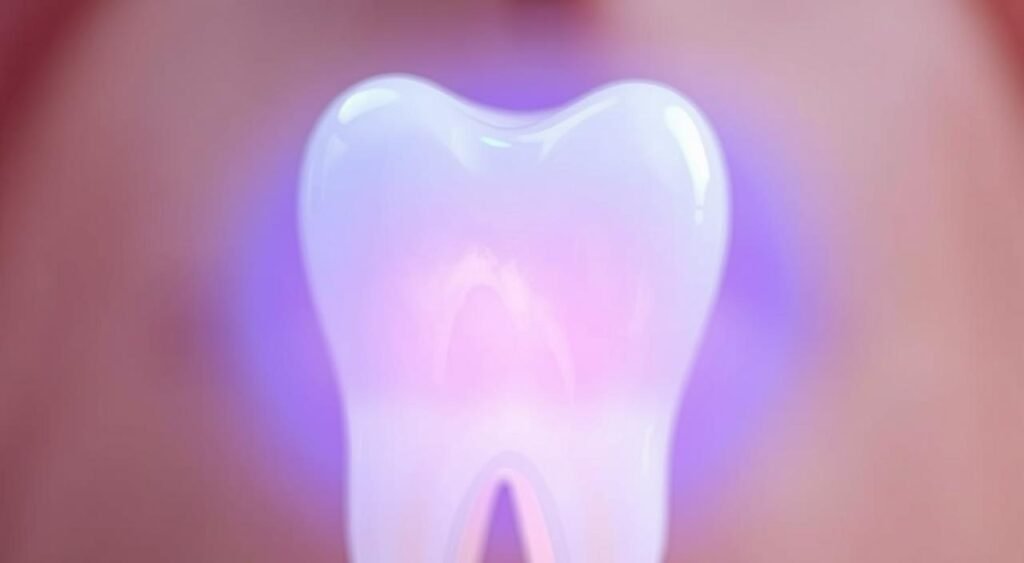Are you chasing a brighter smile but feeling pain instead? Teeth whitening pain is a common issue many face. It’s important to know the risks of this popular beauty treatment.
Teeth sensitivity after whitening is a big problem for many adults. It can feel like a mild twinge or a sharp pain. This usually happens when you eat or drink something hot or cold. The good news is, this pain usually goes away in 24 to 48 hours.
The main reason for this pain is peroxide in whitening products. It can make your tooth enamel weak and expose the dentin. This part of your tooth has tiny tubes that connect to nerves, causing pain.
Knowing why you might feel pain and how to stop it can help. You can get that perfect smile without the pain. Let’s look into this dental issue and find ways to keep your smile bright and pain-free.
Understanding the Causes of Teeth Whitening Pain
Tooth whitening is a popular way to brighten your smile. But, it can sometimes cause discomfort. This pain usually fades away in 24 to 48 hours. Let’s look at why tooth sensitivity and other side effects happen.
Increased Tooth Sensitivity
Tooth sensitivity is common when whitening. The chemicals in whitening products, like hydrogen peroxide, can bother your tooth nerves. This makes your teeth more sensitive to hot or cold foods and drinks. People with thin enamel are more likely to feel this.
Gum Irritation and Sensitivity
Your gums might get irritated during whitening. This happens when the whitening gel touches your gum tissue. It can cause temporary redness and sensitivity. Using custom-fitted trays or professional application can help lessen this issue.
Overuse of Whitening Products
Using whitening products too much can increase tooth sensitivity. It’s key to follow the instructions on home kits or your dentist’s advice. Overusing can harm your enamel and lead to long-lasting sensitivity.
To lessen discomfort, you can:
- Use desensitizing toothpaste before and after treatment
- Take anti-inflammatory medication before whitening
- Brush your teeth before, not after, the whitening treatment
- Consider take-home whitening kits for a gradual process
Remember, some discomfort is normal, but severe pain is not. If you have intense or lasting pain, see your dentist right away.
Common Symptoms of Teeth Whitening Pain
Teeth whitening can cause discomfort for many. Knowing the symptoms helps manage pain better. About two-thirds of people using over-the-counter products feel mild to moderate sensitivity. This pain often comes from the peroxide in whitening gels and how long you use it.
The most common side effects of whitening gels include:
- Increased sensitivity to hot and cold foods
- Discomfort while biting or chewing
- Pain during brushing or flossing
- Sharp pain at tooth roots when eating certain foods
Gum-related symptoms are also common after whitening. These can be redness, swelling, or a burning feeling in your gums. This usually starts a day after treatment and can last for days.
Zingers, or sudden sharp tooth sensitivity, can happen during treatment. This happens when hydrogen peroxide touches the tooth enamel. Some dentists suggest using products without hydrogen peroxide for pain-free whitening.
Proper aftercare is key for whitening treatments. Use desensitizing toothpaste before and after. Taking ibuprofen can also help with pain. Remember, these symptoms usually go away in 24-48 hours.

Teeth Whitening Pain: Prevention and Management
Teeth whitening safety is key when you want a brighter smile. The right product and technique can prevent pain. Let’s look at how to manage and avoid pain during whitening.
Selecting an Appropriate Whitening Product
Choose a whitening product that fits your needs. Professional treatments are often less painful than home kits. For home use, pick products with lower whitening agent concentrations. This can lower pain risk while keeping results effective.
Applying Products Correctly
Always follow product instructions. Don’t leave whitening agents on longer than advised. Use custom trays or strips to avoid gum irritation. This helps prevent discomfort during whitening.
Gradual Treatment Approach
Begin with short treatment times and gradually increase. This lets your teeth get used to whitening. Start with 5-10 minute sessions and slowly increase. Space out treatments for your teeth to recover.
- Use desensitizing toothpaste before and after whitening
- Apply fluoride gel to strengthen enamel
- Take breaks between whitening treatments
- Avoid hot or cold foods immediately after whitening
Remember, everyone’s teeth react differently to whitening. If pain persists, see your dentist. They can suggest better options or adjust your plan for comfort.
Effective Relief Tips for Teeth Whitening Pain
Teeth whitening pain can be a real challenge. But, there are many ways to ease the discomfort. You can try at-home remedies, professional treatments, and make lifestyle changes. These steps help keep your teeth white and healthy.
At-Home Solutions
Home remedies can offer quick relief. Use toothpaste with potassium nitrate to block pain signals. Over-the-counter pain relievers can also help. For a natural fix, try rinsing with warm salt water to soothe your gums.
Professional Dental Care
If home remedies don’t work, your dentist can help. They might apply fluoride gel or desensitizing agents. Some dentists use potassium nitrate gel before whitening to prevent pain. For lasting relief, ask about fluoride varnish, which protects your teeth for months.
Lifestyle Adjustments for Comfort
Small changes in your daily routine can make a big difference. Use a soft-bristled toothbrush to avoid irritating your gums and enamel. Avoid very hot or cold foods and drinks to prevent sensitivity. Adding fluoride mouthwash to your routine can also strengthen your enamel.
Remember, safety is key when whitening your teeth. If pain doesn’t go away or gets worse, see your dentist. They can adjust your whitening plan or suggest other treatments to keep you comfortable.
Conclusion
Teeth whitening treatments are now a big hit in cosmetic dentistry. While most people don’t feel pain, some might feel sensitivity after it. This sensitivity can be mild to moderate and might last a few days.
To ease the discomfort, try using sensitive toothpaste and soft-bristled brushes. Also, avoid eating or drinking things that are too hot or cold. Taking breaks between whitening sessions at home can also help. Remember, everyone’s experience is different because of personal factors.
Before you start any whitening treatment, talk to a dental professional. They can check your teeth and suggest the best method. This way, you can get a brighter smile with less discomfort.
Knowing how dental health and sensitivity are connected is important for whitening treatments. By following expert advice and taking care, you can get a whiter smile with few side effects.
FAQ – Tooth Pain After Whitening
What are the primary causes of tooth pain after whitening?
Tooth pain after whitening often comes from sensitivity, gum irritation, and using too much whitening product. Whitening agents can reach the nerves, causing sensitivity. Gum irritation happens when these agents touch the gums too much. Using whitening products too much can make teeth very sensitive and painful.
What are the common symptoms of teeth whitening pain?
Common signs include feeling pain when eating hot or cold foods. You might also feel pain when biting or chewing. Brushing or flossing can be uncomfortable. There’s a higher chance of tooth decay or cavities. You might see red, swollen gums or feel a sharp pain at the tooth root when eating certain foods.
How can I prevent and manage teeth whitening pain?
To avoid and handle teeth whitening pain, pick the right product and apply it correctly. Start with short treatments and gradually increase the time. Always work with a dentist. Use trays or strips that fit your teeth to avoid gum irritation. Follow the product’s instructions to avoid using too much. Slowly increase how often and how long you use the whitening treatment.
What are some effective relief tips for teeth whitening pain?
For pain at home, try desensitizing toothpaste and over-the-counter pain relievers. Warm saltwater rinses and cold compresses can also help. If the pain is severe, see a dentist. Dentists can apply fluoride gel, desensitizing agents, or fluoride varnish. To help, avoid foods that trigger pain, brush gently, and use fluoride mouthwash.
What role do potassium nitrate and hydrogen peroxide play in teeth whitening pain?
Potassium nitrate in toothpaste can help with whitening pain. Hydrogen peroxide, on the other hand, can make teeth more sensitive and painful because it penetrates the enamel.
Is it safe to use over-the-counter pain relievers for teeth whitening pain?
Over-the-counter pain relievers can help with mild to moderate pain. But, for severe pain, see a dentist. They can find and treat any underlying issues.









2 Comments
Pingback: Teeth Whitening for Porcelain Veneers: Proven Glow Tips
Pingback: How Do You Use a Teeth Whitening Pen: Easy Steps